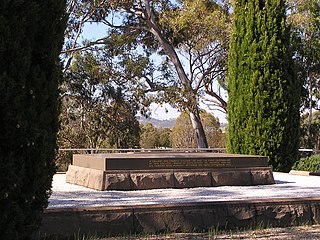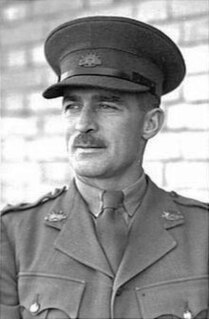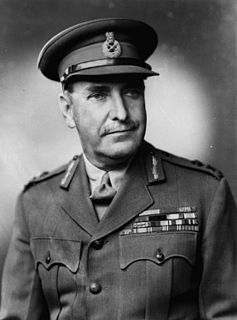
The Royal Australian Air Force (RAAF), formed March 1921, is the aerial warfare branch of the Australian Defence Force (ADF). It operates the majority of the ADF's fixed wing aircraft, although both the Australian Army and Royal Australian Navy also operate aircraft in various roles. It directly continues the traditions of the Australian Flying Corps (AFC), formed on 22 October 1912. The RAAF provides support across a spectrum of operations such as air superiority, precision strikes, intelligence, surveillance and reconnaissance, air mobility, space surveillance, and humanitarian support.

Major General Sir William Throsby Bridges, was a senior Australian Army officer who was instrumental in establishing the Royal Military College, Duntroon and who served as the first Australian Chief of the General Staff. During the First World War he commanded the 1st Australian Division at Gallipoli, where he died of wounds on 18 May 1915, becoming the first Australian general officer to be killed during the war. He was the first Australian—and the first graduate of Kingston—to reach the rank of major general, the first to command a division, and the first to receive a knighthood. He is one of only two Australians killed in action in the Great War to be interred in Australia.

The First Australian Imperial Force was the main expeditionary force of the Australian Army during World War I. It was formed on 15 August 1914, following Britain's declaration of war on Germany, initially with a strength of one infantry division and one light horse brigade. The infantry division subsequently fought at Gallipoli between April and December 1915, being reinforced by a second division which was later raised, as well as three light horse brigades. After being evacuated to Egypt the AIF was expanded to five infantry divisions, which were committed to the fighting in France and Belgium along the Western Front in March 1916. A sixth infantry division was partially raised in 1917 in the United Kingdom, but was broken up and used as reinforcements following heavy casualties on the Western Front. Meanwhile, two mounted divisions remained in the Middle East to fight against Turkish forces in the Sinai and Palestine.

The Australian Corps was a World War I army corps that contained all five Australian infantry divisions serving on the Western Front. It was the largest corps fielded by the British Empire in France. At its peak the Australian Corps numbered 109,881 men. By 1918 the headquarters consisted of more than 300 personnel of all ranks, including senior staff officers, as well as supporting personnel such as clerks, drivers and batmen. Formed on 1 November 1917, the corps replaced I Anzac Corps while II Anzac Corps, which contained the New Zealand Division, became the British XXII Corps. While its structure varied it usually included 4–5 infantry divisions, corps artillery and heavy artillery, a corps flying squadron and captive balloon sections, anti-aircraft batteries, corps engineers, corps mounted troops, ordnance workshops, medical and dental units, transport, salvage and an employment company.

III Marine Expeditionary Force is a formation of the Marine Air-Ground Task Force of the United States Marine Corps. It is forward-deployed and able to rapidly conduct operations across the spectrum from humanitarian assistance and disaster relief (HA/DR) to amphibious assault and high-intensity combat.

Lieutenant General Sir John Northcott was an Australian Army general who served as Chief of the General Staff during the Second World War, and commanded the British Commonwealth Occupation Force in the Occupation of Japan. He was the first Australian-born Governor of New South Wales.

Brigadier General Cecil Henry Foott was a senior Australian Army officer who served as Chief Engineer of the Australian Corps in the First World War. He was educated as an engineer and, serving with distinction in senior staff and engineering positions through the First World War, was seven times mentioned in despatches.

The 49th Infantry Brigade, also known as 49 (East) Brigade, was a brigade of the British Army.

HQ Northern Ireland was the formation responsible for the British Army in and around Northern Ireland. It was established in 1922 and disbanded, replaced by a brigade-level Army Reserve formation, 38 (Irish) Brigade, in 2009.

The Australian Women's Army Service (AWAS) was a non-medical women's service established in Australia during the Second World War. Raised on 13 August 1941 to "release men from certain military duties for employment in fighting units" the service grew to over 20,000-strong and provided personnel to fill various roles including administration, driving, catering, signals and intelligence. Following the end of the Second World War, the service was demobilised and ceased to exist by 1947. It later provided a cadre of experienced personnel to the Women's Royal Australian Army Corps when it was established in 1951.

Lieutenant General Sir Frank Horton Berryman, was an Australian Army officer who served as a general during the Second World War. The son of an engine driver, he entered Duntroon in 1913. His class graduated early after the First World War broke out, and he served on the Western Front with the field artillery. After the war, he spent nearly twenty years as a major.

Lieutenant General Sir Reginald George Pollard, was a senior commander in the Australian Army, serving as Chief of the General Staff from 1960 to 1963. Born in Bathurst, New South Wales, Pollard graduated from the Royal Military College, Duntroon, in 1924. A regular officer, he served as adjutant/quartermaster in several battalions of the Citizens Military Forces (CMF) during the 1920s and 1930s. In 1938, he was posted to England to undertake staff training, which was cut short by the outbreak of the Second World War. Pollard joined the Second Australian Imperial Force in 1940, and the following year saw action with the 7th Division in the Middle East, where he was mentioned in despatches. Promoted to colonel in 1942, he became senior staff officer of the 7th Division in New Guinea, and was awarded the Distinguished Service Order for his actions. He spent much of the remainder of the war in staff and training positions in Australia.

Lieutenant General Sir John Dudley Lavarack, was an Australian Army officer who was Governor of Queensland from 1 October 1946 to 4 December 1957, the first Australian-born governor of that state.

Lieutenant General Sir Henry Wells, was a senior officer in the Australian Army. Serving as Chief of the General Staff from 1954 to 1958, Wells' career culminated with his appointment as the first Chairman, Chiefs of Staff Committee, a position marking him as the professional head of the Australian Military. He served in this capacity from March 1958 until March 1959, when he retired from the army.

Lieutenant General Edward Kenneth Smart, was a career officer in the Australian Army, and subsequently a diplomat.

Lieutenant General Sir Alwyn Ragnar Garrett, KBE, CB was a senior commander in the Australian Army. He served as Chief of the General Staff (CGS) from 1958 to 1960.

Major General John Stewart Whitelaw, was a senior officer in the Australian Army. Whitelaw was a graduate of the first intake of the Royal Military College, Duntroon and served briefly at Gallipoli with an infantry battalion during the First World War. His war service was, however, cut short by a bullet wound suffered during the landing on 25 April 1915 and he returned to Australia where, during the interwar years, he transferred to the artillery and undertook a number of staff and instructional postings. During the Second World War, although he did not serve overseas in an operational role, in his capacity as a senior artillery officer Whitelaw had responsibility for all matters relating to the development of artillery in the Australian Army and in this role he championed the introduction of new technologies and weaponry into the corps and the development of Australian defence industries.

Major General Colin Hall Simpson, was an Australian Army officer who rose to the rank of major general as Signal Officer in Chief during the Second World War. He was one of the founders of Amcal, the largest retail pharmacy chain in Australia.

Earl Sanford Piper was a highly decorated officer in the United States Marine Corps with the rank of Brigadier General. A veteran of Nicaraguan Campaign, Piper distinguished himself under fire and received Navy Cross, the United States military's second-highest decoration awarded for valor in combat. He later participated in the Battle of Iwo Jima and Chinese Civil War.






















